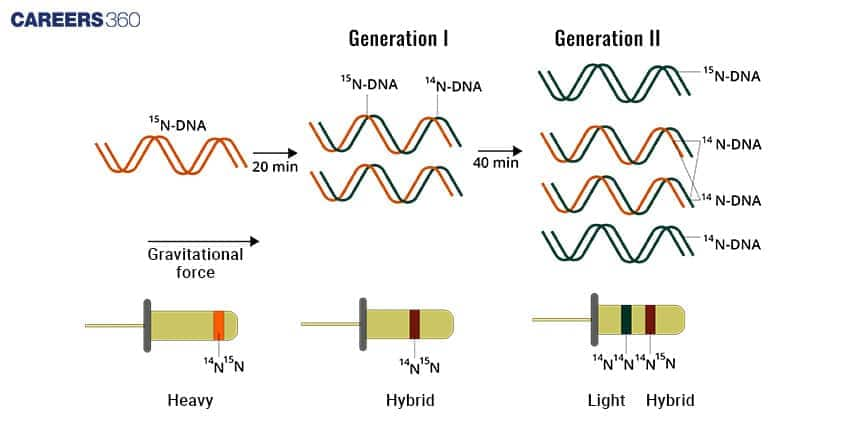Meselson And Stahl Experiment on DNA Replication
The Meselson and Stahl Experiment is an experiment by Matthew Meselson and Frankil Stahl in 1958. This experiment supported Watson and Crick’s hypothesis that DNA replication was semiconservative. In semiconservative replication, the double-stranded DNA helix is replicated, forming each of the two new double-stranded DNA helices. The two strands consist of one strand from the original helix and one that is newly synthesised.
This Story also Contains
- History of the Experiment
- Concept of DNA Replication
- Discovery of DNA Structure
- DNA Replication Hypotheses
- The Scientists: Meselson and Stahl
- Experimental Design of Meselson and Stahl Experiment
- Step-Wise Procedure
- MCQs on Messelson and Stahl Experiment

Meselson and Stahl did the experiment to trace the parent DNA and tag it by changing one of its atoms. As nitrogen is present in all DNA bases, they produced parent DNA containing a heavier isotope of nitrogen. This altered mass allowed them to determine how much of the parent DNA was present in the DNA after replication cycles. Meselson and Stahl's experiment is a topic of the chapter Molecular Basis of Inheritance. It is an important chapter in the Biology subject.
History of the Experiment
The Meselson and Stahl experiment, conducted in 1958, is a classic in molecular biology that provided unequivocal proof for the semi-conservative mechanism of DNA replication. The experiment gave a clear view of how DNA strands separate and become templates for new strands. It nailed down the basics of how we understand genetics in terms of inheritance and how their materials are to be replicated.
Concept of DNA Replication
Replication of DNA is a process wherein one double-stranded DNA molecule is copied to replicate two identical DNA molecules. This process lies at the core of cell division, as through this, one generation can pass genetic material to succeeding generations. The Meselson-Stahl experiment tested models of DNA replication that had been proposed: the conservative, semi-conservative, and dispersive. Even the central dogma of molecular biology indicates that DNA replicates.
Discovery of DNA Structure
In 1953, James Watson and Francis Crick discovered and gave the feature of the double helix structure of DNA, making explicit the molecular basis of genetic inheritance. Their model indicated that each strand of the DNA double helix could act as a template for generating a new complementary strand. It gave indications for the existence of a semi-conservative mechanism for DNA replication.
DNA Replication Hypotheses
There were three models put forward to account for how DNA replicates:
Conservative Model: In this model, the original DNA molecule remains intact, and an entirely new molecule is synthesised.
Semi-Conservative Model: Each of the two new DNA molecules would contain one old strand and one newly synthesised strand.
Dispersive Model: Here the original DNA molecule breaks into pieces, and new DNA is synthesized in a dispersed pattern mixing old and new DNA segments.
The Scientists: Meselson and Stahl
Matthew Meselson: This American geneticist and molecular biologist was born in 1930. His work on the points of DNA replication and repair mechanisms brought our knowledge about them a long way forward.
Franklin Stahl: An American geneticist born in 1929, Stahl is also one of the leading investigators in molecular biology and in genetic recombination and DNA replication.
Roles and Contributions
The Meselson and Stahl collaboration on the DNA replication experiment radicalised molecular biology by providing solid experimental proof for the semiconservative model of DNA replication. Their work established certain methodologies that later proved to be milestone procedures for future studies in genetics.
Experimental Design of Meselson and Stahl Experiment
The main objective of the experiment by Meselson and Stahl was to ascertain the correct model of DNA replication through differentiation between the conservative, semiconservative, and dispersive models.
Materials And Methods
The reason for choosing E. coli is because of its fast growth rate and well-known genetics. Hence, it would provide a very good model organism in the DNA replication study.
Significance of using Nitrogen Isotopes (15N and 14N)
Meselson and Stahl used the heavy nitrogen (15N) and light nitrogen (14N) isotopes to label the DNA. First, E. coli bacteria were grown in 15N medium to ensure that all DNA in the bacteria contained this heavy isotope. Then, transferring them to a 14N medium allowed them to trace how the lighter isotope entered newly replicated DNA strands.
Step-Wise Procedure
The step-wise breakdown on how Meselson and Stahl did their experiment to prove that DNA replication is semi-conservative is given below-
1. Culture of E. Coli In 15N :
E. coli were grown for several generations on a medium with 15N so that all its DNA was labelled with the heavy nitrogen isotope.
2. Shifting to 14N Medium:
The bacteria were transferred into a medium containing 14N. At different time intervals, samples of DNA were withdrawn to monitor the incorporation of the lighter isotope.
3. Extraction and Analysis of DNA Samples:
DNA was isolated from the bacterial cells in density gradient centrifugation, a method that separates DNA according to its density.
Diagram: Meselson And Stahl's Experiment
The diagram given below shows the process of Meselson and Stahl's experiment:

Results of the Experiment
The results of the experiment are as follows:
Generation 0 (Heavy DNA)
After growing in the 15N medium, E. coli DNA was extracted and run through the density gradient, resolved into a single discrete band, which corresponded to heavy DNA (15N-15N).
Generation 1 (Hybrid DNA)
After one replication cycle on a 14N medium, the gradient contained a single band of intermediate density, characteristic of hybrid DNA. This was inconsistent with the conservative model of replication by which two separate bands should have appeared, one heavy and one light.
Subsequent Generations
After two rounds of replication, two bands appeared: one at the middle position and another at the light DNA position (14N-14N). The result conformed to the semiconservative model. That is, every new DNA molecule contains one old strand and one new strand.
MCQs on Messelson and Stahl Experiment
Q1. Assertion [A]: The nature of DNA replication is semiconservative.
Reason [R]: Newly formed DNA contains one daughter and one parent DNA
Option 1: Both, A and R, are correct and R explains A
Option 2: Both, A and R, are correct but R not explains A
Option 3: A is correct but R is wrong
Option 4: A is wrong but R is correct
Correct answer: 1) Both, A and R, are correct and R explains A
Explanation:
DNA replication is categorized as "semiconservative" because parental DNA strands are passed to newly produced daughter DNA helices, while the other strand appears to be complementary to DNA. DNA replication is also "semi-discontinuous". One strand of DNA is continuously developed whereas complementary DNA is discontinuously formed through Okazaki fragment
Hence, the correct answer is Option 1) Both, A and R, are correct and R explains A
Q2. Components used in Meselson and Stahl's experiment
Option 1: Heavy Nitrogen
Option 2: Radioactive Nitrogen
Option 3: CsCl (Cesium Chloride)
Option 4: Any two of them
Correct answer: (4) Any two of them.
Explanation:
Experiments done by Meselson and Stahl -
They grew E.Coli in a medium containing  (
(![]() is the heavy isotope of nitrogen). As a result
is the heavy isotope of nitrogen). As a result ![]() was incorporated into newly synthesized normal DNA by centrifugation in a cesium chloride (
was incorporated into newly synthesized normal DNA by centrifugation in a cesium chloride (![]() ) density gradient.
) density gradient.
Hence, the correct answer is Option (4) Any two of them.
Q3. The method developed by Meselson and Stahl to separate heavy DNA with N’s from DNA N’4, for providing evidence for semi-conservative replication of DNA is
Option 1: Ion exchange chromatography
Option 2: Density gradient centrifugation
Option 3: Isopycnic centrifugation
Option 4: Gel filtration
Correct answer: 2) Density gradient centrifugation
Explanation:
Experiments done by Meselson and Stahl -
They transferred the E. coli bacteria Cells into a medium with normal 14NH4Cl samples and extracted DNA Various samples were separated independently on CsSl gradients to measure. the deities of DNA.
Hence, the correct option is 2) Density gradient centrifugation
Also read-
Frequently Asked Questions (FAQs)
Nitrogen isotopes were used in their experiment since they could label DNA where the old strands could have a different density from the newly synthesised strands.
This experiment made possible the confirmation of a semi-conservative model of DNA replication, which formed the very bedrock of modern assessment in the process of genetic inheritance, DNA repair, and current genetic techniques.
The main objective was to prove one of these three models of DNA replication: conservative, semi-conservative, and dispersive.
Using nitrogen isotopes and density gradient centrifugation, they demonstrated that one round of DNA replication contains hybrid strands while successive rounds produce both hybrid and light DNA.
The experiment resorted to E. coli bacteria, nitrogen isotopes (¹⁵N and ¹⁴N), and centrifugation on a density gradient to discriminate between different models of DNA replication.